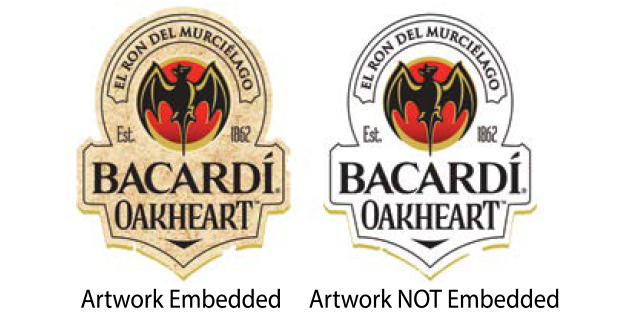Art Requirements
- Art must be provided in vector format:.eps, .ai or .pdf
- Artwork must be set up on the correct supplied template to ensure artwork is printed correctly
- Do not delete cut lines from template when submitting artwork
- For images to be considered vector art they must be created in a vector based program like Adobe Illustrator
- All raster images (like photos) must be sized at 100%
- Maximum resolution should be no higher than 300 dpi or less than 150 dpi at the final size
- Background color(s)/images need at least 2” of bleed around all edges
- Use Pantone Solid Coated colors
- To avoid ink bleeding into small areas of white, we recommend white text be a minimum of 0.13" thickness
- All fonts must be outline format
- Embed all images
- Make sure all graphics are visible when overprint preview is selected
- PLEASE DO NOT EMAIL ARTWORK THAT IS MORE THAN 5MB IN FILE SIZE. It will not be accepted by our mail server. For larger files please upload your artwork to Quinn through the following link: https://quinnflags.wetransfer.com. Upload instructions here. To make sending art easier you may also compress your artwork using either WinZip (free trial version available) or WinRar (free trial 64-bit version available). We cannot accept StuffIt files.
- Learn more about print quality expectations
Vector Art(Recommended for all products) Can be scaled to any size while maintaining quality. Also known as lineart. Vector artwork is preferred, unless printing photos. |  |
Raster ArtComposed of pixels, tiny colored squares grouped together to make one big image. When scaled larger, image will look jagged or “pixelated.” |  |
Outlined Fonts(Recommended for all products) Fonts can vary from computer to computer. When a font is missing, the computer replaces it with a generic font. Fonts must be converted to outlines to display correctly. |  |
Embedded Images(Recommended for all products) Most programs allow the user to add an object or image to a file by linking or embedding. Embedded images are stored within the document itself, while linked files are not. Because of this, linked files can become unlinked and “go missing” when opened on a different computer. Embed all images to avoid missing images. |  |
Downloadable Art Requirements (Acrobat Reader Required)
Frequently Asked Questions
Q: Why do you need vector art, can’t you just use any image file?
A: Vector art is the standard for the printing industry, it is used for printing shirts, graphics, flags, etc. One of the main features that makes it so perfect for this industry is the ability to resize it without it becoming pixelated. So for instance, you can take a 1” x 3” vector image and stretch it to fit a 10’ x 13’ printing surface. If you try to stretch a non vector image it will distort and become pixelated, this will not create a nice finished product.
Q: If I import a non vector image (.jpeg, .bmp, .gif, .psd) into Adobe Photoshop or Adobe Illustrator and save it as a .eps or .ai file isn’t that vector?
A: No, simply saving a non vector image as an .eps or .ai file does not make it vector, and we will not be able to use it on your flag.
Q: Can you recreate my art as vector?
A: Yes, for an additional art charge we can create your art as vector. However the art needs to be large and clear enough for us to see ALL the details in the image. If we can’t see all the details we will not know how the image should look in order to re-create it. An example of good art that we can work with would be THIS. The image is large and clear, and we will have no problem re-creating vector art from it. An example of bad art would be THIS. The image is very small and we cannot see any details, we will not be able to make vector art from it.
Q: Can I email my art?
A: Yes, as long as it is under 5MB. If it is any larger than that our mail server will not accept it. If you have art larger than 5MB you can try compressing it using a program like WinZip (free trial version available) or WinRar (free trial 64-bit version available). If the art is still too large to email, please upload your artwork to Quinn through the following link: https://quinnflags.wetransfer.com. Upload instructions here.
Q: Can I use clip art in my art?
A: You can use any clip art as long as it is vector (.ai or .eps).
Q: What fonts can I use?
A: You can use any fonts but you need to outline any fonts before you send the artwork. If you do not do this, it will delay your order until we receive the outlined fonts from you. If we don’t have the correct fonts, our computers will replace it with a standard font that might not match the one that you used, as a result, the art might not look the same as it appears on your computer, and will not print the same. To outline your fonts in Illustrator you can select ALL fonts in the art, go to the ‘Type’ menu, and select ‘Create Outlines’ this will turn the selected text into a graphic, then our computers will be able to open the art without having the font files. All fonts must be outlined to prevent delays from missing fonts.
Q: What color book do you use?
A: We only use PANTONE SOLID COATED for digital printing. Any other Pantone or Custom Spot color will be converted to the closest matching Pantone solid coated color.
Q: What version of Adobe Illustrator are you running?
A: We are currently running Adobe Illustrator Cloud on Windows operating systems.
Q: Why do I need to pick PMS colors?
A: In order to effectively communicate color, we use the Pantone Matching System. Pantone color guides are the international standard used to match colors providing printed samples of expected color. Also, most popular design software provides Pantone color libraries for designing. Our calibrated digital printing system can match most Pantone Solid Coated colors. When using CMYK process color we cannot accurately measure the quality of color to your expected color match. Please select your own Pantone colors from our Online Color Reference Chart or we can match the existing colors in your art to the closest Pantone Solid Coated colors.
Q: How big can the design be on my flag?
A: With most of our products, the imprint / design area needs to have a certain amount of space from edges to allow for stitching and finishing. Refer to the template for imprint size.
Q: How long will my digital flag last?
A: There is no one answer to this question. There are a lot of variables that will determine the life span of a flag. Some of the variables can be: where it is flown, in what weather conditions, and even how much direct sunlight the flag receives. All flags that are flown outdoors will eventually wear out, the sun will fade the colors, and the wind will eventually cause the fly end of the flag to tatter and tear. Just as the soles of your shoes or the tires on your automobile will wear out faster the more they are used, a flag flying at the top of a flagpole in all weather conditions, 24 hours a day, 7 days a week will wear out too. To get the maximum life out of your flag, you should take your flag down at night and during bad weather, like rain, snow, and strong wind. If you notice that the fly end of your flag is coming apart, sew it back up before it gets worse.
Q: What is digital printing?
A: Digital printing is the reproduction of digital images on a physical surface, such as photographic paper, film, cloth, plastic, etc. Digital printing is broad in its definition, it is a printing process where all electronic documents are transferred digitally from workstations directly to the press. Film output, film assembly and plate processing are not part of the workflow as in conventional offset printing, and the cost for those materials have been eliminated. Without the need to create a plate, digital printing has brought about fast turnaround times and printing on demand. Instead of having to print large, pre-determined runs, requests can be made for as little as one print. Images are captured from a matrix of dots, generally called pixels, this process is called digitizing. The digitized image is then used to digitally controlled deposition of ink, toner or exposure to electromagnetic energy, such as light, to reproduce images.
Some things to consider: 1. The lighter the color, the lighter the penetration into the material that it is being printed on. This will also result in faster fading of the color. 2. The material that is being used - different materials absorb the inks differently. 3. Gradients - if your vector art has a gradient of colors (example: Blue into Green or Red into Orange) then when the flag is printed the area where the colors merge into each other might not be as smooth as it appears on your proof. This is due to the dot printing process.
Q: Do you have templates I can download?
A: Yes. We have a collection of vector templates for our most popular products.
Q: Can custom-made flags, banners, and other imprinted products be returned?
A: Non-stock (made to order) products are: any Custom-made flags, banners, pennants, and/or any item with a custom logo or imprint, Non-stock (made to order) and Custom-Made products are 100% non-refundable. If there is a manufacturers defect, we will review product(s) once the authorized returned merchandise is received to determine the nature of the situation. Every customer will receive a digital proof to review prior to production granting us the right and customer permission to proceed. Any errors made in customer oversight on the proof is the customers’ liability. Please read entire proof thoroughly as custom-made products are non-refundable.
PROOFING GUIDELINES
If you supply vector artwork, you will receive 1 proof and 1 revision at no charge. Any further revisions will be $25 per revision thereafter. If we create vector artwork for you (which means we are creating it from scratch or creating from non-vector art), you will receive 1 proof and 2 revisions at no charge. Any further revisions will be $25 per revision thereafter.

